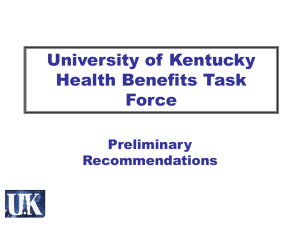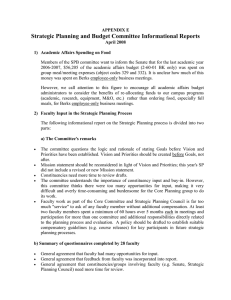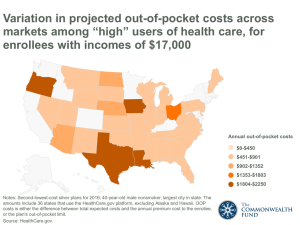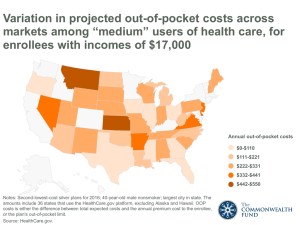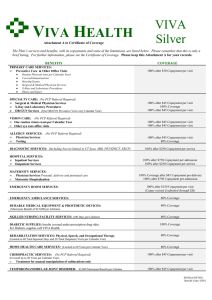1) The University should increase its support for health... 2003 (July 1, 2002-June 30, 2003).
advertisement
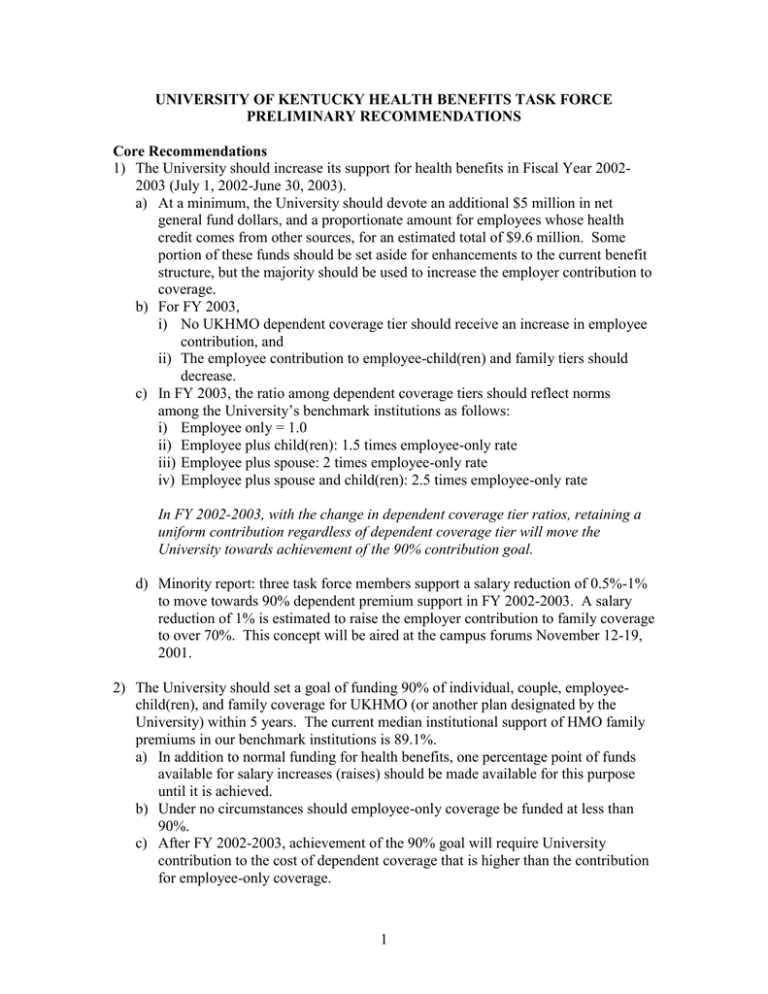
UNIVERSITY OF KENTUCKY HEALTH BENEFITS TASK FORCE PRELIMINARY RECOMMENDATIONS Core Recommendations 1) The University should increase its support for health benefits in Fiscal Year 20022003 (July 1, 2002-June 30, 2003). a) At a minimum, the University should devote an additional $5 million in net general fund dollars, and a proportionate amount for employees whose health credit comes from other sources, for an estimated total of $9.6 million. Some portion of these funds should be set aside for enhancements to the current benefit structure, but the majority should be used to increase the employer contribution to coverage. b) For FY 2003, i) No UKHMO dependent coverage tier should receive an increase in employee contribution, and ii) The employee contribution to employee-child(ren) and family tiers should decrease. c) In FY 2003, the ratio among dependent coverage tiers should reflect norms among the University’s benchmark institutions as follows: i) Employee only = 1.0 ii) Employee plus child(ren): 1.5 times employee-only rate iii) Employee plus spouse: 2 times employee-only rate iv) Employee plus spouse and child(ren): 2.5 times employee-only rate In FY 2002-2003, with the change in dependent coverage tier ratios, retaining a uniform contribution regardless of dependent coverage tier will move the University towards achievement of the 90% contribution goal. d) Minority report: three task force members support a salary reduction of 0.5%-1% to move towards 90% dependent premium support in FY 2002-2003. A salary reduction of 1% is estimated to raise the employer contribution to family coverage to over 70%. This concept will be aired at the campus forums November 12-19, 2001. 2) The University should set a goal of funding 90% of individual, couple, employeechild(ren), and family coverage for UKHMO (or another plan designated by the University) within 5 years. The current median institutional support of HMO family premiums in our benchmark institutions is 89.1%. a) In addition to normal funding for health benefits, one percentage point of funds available for salary increases (raises) should be made available for this purpose until it is achieved. b) Under no circumstances should employee-only coverage be funded at less than 90%. c) After FY 2002-2003, achievement of the 90% goal will require University contribution to the cost of dependent coverage that is higher than the contribution for employee-only coverage. 1 d) The University should monitor benchmark health benefits to maintain parity during and after the achievement of 90% funding. Inadequate funding of dependent coverage has impeded the University’s recruitment and retention at all levels. Inadequate funding has also caused many employees to drop coverage for their dependents, leaving the remaining group older and less healthy. The current budgetary situation of the University and the state makes immediate achievement of this goal unrealistic. However, reaching the 90% funding level is critical to the University’s competitive position in both faculty and staff recruitment. 3) The University should offer a lower benefit option at an employee contribution rate approximately 20% lower than the rate for UKHMO in order to provide more affordable dependent coverage while moving towards the 90% overall contribution rate. This plan should have the following features: a) Use managed care strategies rather than significantly higher copayment levels to avoid over-utilization. b) Possibly allow out-of-network utilization at high out-of-pocket cost (e.g., 50% coinsurance) c) Impose annual or lifetime benefit limit d) Possibly exclude some benefits that are now covered e) Limit impact on cost of care for children f) Impose a copayment for adult outpatient primary care provider visits other than annual preventive care visit in order to discourage unnecessary physician office visits, lower the cost of the plan, and offset the cost of other benefits that have been retained g) This offering would disappear when employer contribution parity with benchmarks is achieved Actuarial evaluation: The goal of a 20% lower cost will be difficult to achieve within an acceptable benefit range. 4) The University should identify alternative benefit designs that better meet the needs of Medicare-eligible retirees, based on the following principles: a) Continue to contribute the same dollar amount towards retiree coverage as for active employee-only coverage b) Explore mechanisms for lowering retirees’ exposure to high out-of-pocket costs for prescription drugs, such as a separate out-of-pocket maximum for prescription drugs or inclusion of drugs in the existing out-of-pocket maximum for other services c) Retain protection against catastrophic financial loss d) Retain coverage for medically necessary and preventive services not covered by Medicare e) Explore effect of actuarially rating Medicare-eligible retirees separately from the active employee group f) Support appointment of a retiree to the University’s Employee Benefits Committee 2 g) Support surviving spouses’ coverage at the same percentage rate as family coverage for active employees, i.e., up to 90% when a 90% support level is achieved for family coverage. 5) Corrections to UKPPO plan design. UKPPO’s current benefit structure does not cover hospital-based ancillary services at the same level as services provided in a physician’s office. Ancillary services that are billed through a hospital (such as those associated with outpatient care at Kentucky Clinic) are subject to the PPO deductible of $500 for a single enrollee. Because patients generally do not select the mode in which their ancillary services are billed, this distinction appears inequitable. a) 100% coverage of screening mammograms (within scope of covered benefits) after $20 copayment b) Coverage of laboratory services associated with an outpatient visit at the same benefit level regardless of whether the service is performed by a laboratory classified by Humana as hospital-based or outpatient. Actuarial input: The cost of these changes could increase premium rates by 4-5%. 6) Network expansion and enrichment. The surveys and focus groups conducted on behalf of the task force identified many problems with access to care. The following recommendations address access issues outside the Lexington Service Area. a) CHA Health, whose network is used in the UKHMO Regional Service Area, and Humana, whose network is used in the UKPPO, should be encouraged to expand their existing networks and add to them in counties already served so that as many major hospitals as possible are included. b) Specific standards should be set for network adequacy and it should be assessed carefully in future contract negotiations. c) Because preferred participating pharmacies (Kroger, Kentucky Clinic, and Appalachian Regional Healthcare) are only available in 45 counties and are not available in the largest city in three additional counties, UKHMO and UKPPO should identify ways to provide all members with the same level of prescription drug benefit at the same out-of-pocket cost. If preferred participating pharmacies cannot be made available within a reasonable driving distance of all members, the University should waive the additional $5 copayment required when members without reasonable preferred pharmacy access fill prescriptions as participating non-preferred pharmacies. 7) UKHMO issues. The task force surveys and focus groups also identified problems with access to both primary care and specialty services in the UKHMO Lexington Service Area. Representatives of UKHMO assured the task force that they were recruiting additional physicians. a) Access to primary care physicians i) UKHMO should determine its current ratio of available primary care provider appointment hours (or full-time physician equivalents) to membership (separately for adults and children); ii) Set a goal and timetable for improvement, in keeping with national standards; 3 b) c) d) e) iii) Incorporate this standard into subsequent UKHMO contracts with the University. UKHMO should monitor its primary care and specialist clinics for timeliness of patient care i) Both queuing time (i.e., time to get an appointment) and waiting room time; ii) Report problems and correction plans quarterly to the Employee Benefits Committee UKHMO should undertake an annual assessment of the quality of patient care i) Report to University administration and the Employee Benefits Committee, ii) Using the National Committee for Quality Assurance’s Health Plan Employer Data and Information Set (HEDIS) as a model. The Benefits Office should perform an annual UKHMO member satisfaction survey and report to the Employee Benefits Committee UKHMO should assure that all departments communicate departure of primary care physicians to their patients in a timely manner Additional recommendations 8) Issues for off-campus employees a) Employees outside the UKHMO Lexington Service Area should be allowed to enroll in UKHMO RSA or UKPPO if it is offered in the county where they live or the county where they work. They are currently limited to plans offered in the county where they live. b) Employees who do not have UKHMO as an option where they work or live, particularly those who can only select the Indemnity plan, are forced to incur higher health care costs than their fellow employee in counties within the UKHMO service area. Until UKHMO is available statewide, the University should consider increasing the employer contribution to their coverage so that the employee share of the premium for the least expensive option (other than the low option described in #3) available to the employee is equal to the UKHMO rate. 9) To address the widespread call for increased employee choice and access to additional health care providers, the University should explore offering a high option plan with a more comprehensive statewide network than is currently available. Actuarial input: Proposed alternative of offering indemnity plan to any employee. 10) Plan design suggestions: a) The University’s administration should restructure the prescription drug benefit design with the following goals: i) Cost containment ii) Copayment schedule that more accurately reflects the costs and benefits of specific drugs iii) Consideration for those whose health conditions require the use of expensive drugs. b) UKHMO primary care physician office visit copayment for adult visits other than annual preventive care visit 4 c) Cover treatment and medication for children (to age 18) diagnosed with attention deficit disorder with or without hyperactivity; evaluate cost after one year and determine whether age limit should be lifted. Design recommendations and actuarial assessment are being requested from Humana and UKHMO for incorporation into final report (to be completed December 4). 11) The University should provide financial support for the College of Pharmacy proposal (attached) at a rate proportional to UKHMO’s utilization of Kentucky Clinic pharmacy services 12) The University should continue to support the proposal of the Wellness Program (attached) in the areas of preventive service analysis, wellness initiatives, and improved member education. a) In addition, Wellness Program staff should work with University administrators to identify ways to encourage healthy lifestyle practices among employees and students b) The task force supports appointment of Wellness Director ex officio to the Employee Benefits Committee 13) Customer service and management capacity should be enhanced, for example with: a) More resources for benefits office and self-funded plan management. Benefits office staffing and information technology have not been improved to accommodate the added burden associated with self-insurance. Additional staff should be hired to provide more in-house expertise, improve timeliness and accuracy of communication, and enhance member education. b) Proactive monitoring by UKHMO of service capacity, timeliness, office staff interaction with members instead of relying on members to bring problems to plan’s attention c) Better customer information about how to contact health plans d) Consistency, timeliness, and accuracy of response to member inquiries e) Complete and up-to-date website materials f) Timely and accurate plan documents, identification cards, and other personal materials g) Better employee orientation to health benefits, encouraging early selection of a primary care provider (for UKHMO members), using a variety of approaches such as on-line training and interactive kiosks as well as traditional lecture format. h) More comprehensive information for new retirees 14) Eligibility issues a) The University should allow same-sex domestic partners to be covered under University health benefit plans if they meet criteria similar to those used by other universities for such coverage b) After the 90% contribution goal is achieved, the University should explore the cost and benefit of making a proportional contribution to coverage for employees who work more than 20 hours per week but less than the hours necessary to qualify for the current University contribution. 5 Actuarial input: Part-time coverage needs to be assessed carefully because of the potential for adverse selection, i.e., people taking part-time positions with the University with a primary goal of having access to group health insurance. 6
